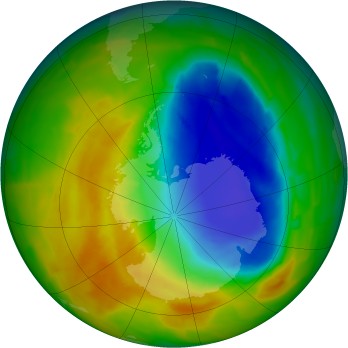The South Pole lives in a state of constant frustration, always overshadowed by its northern counterpart. Santa this; unprecedented ice melt that. Well, guess what, North Pole? The South Pole can make news, too.
Warmer air temperatures high above the Antarctic led to the second smallest seasonal ozone hole in 20 years, according to NOAA and NASA satellite measurements. This year, the average size of the ozone hole was 6.9 million square miles (17.9 million square kilometers). The ozone layer helps shield life on Earth from potentially harmful ultraviolet (UV) radiation that can cause skin cancer and damage plants.
The Antarctic ozone hole forms in September and October, and this year, the hole reached its maximum size for the season on Sept. 22, stretching to 8.2 million square miles (21.2 million square kilometers), roughly the area of the United States, Canada and Mexico combined. In comparison, the largest ozone hole recorded to date was in 2000 at 11.5 million square miles (29.9 million square kilometers).
The graph below shows how significant the difference has been this year compared to the previous two and the average range for two decades prior. The shift is significant.

NOAAClick to embiggen.
It’s impossible not to discuss the reversal of fortune for the ozone layer without noting how it came about. Beginning in 1989, the Montreal Protocol went into effect, a standard brokered by the United Nations that eliminated the use of certain chemicals that were shown to affect the hole. (The companies that produced and sold those chemicals, of course, insisted that there was no correlation.)
Can you even imagine? The world notices an environmental problem and swiftly moves to address it, overriding the concerns of the profiteers who’d rather not be put out of business? It’s like a science fiction novel.
Which brings us back to the first part of that quote, above. “Warmer air temperatures.” Those warmer air temperatures are having effects beyond the ozone hole, of course, including melting the runway that one of Australia’s Antarctic stations uses for resupplies.
Rampant, unchecked global warming — if only there were precedent for taking international action! etc. etc. — means a smaller and smaller ozone hole, and an ice-free Arctic. An ice-free Arctic that will no doubt hog the spotlight.
Even in a race to the bottom, the South Pole can never win.


